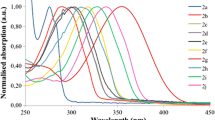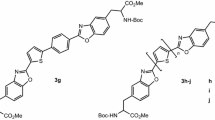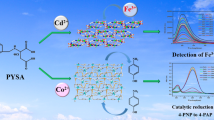Abstract
Highly emissive heterocyclic asparagine derivatives bearing a 1,3,4-thiadiazolyl unit at the side chain, functionalised with electron donor or acceptor groups, were synthesised and evaluated as amino acid-based fluorimetric chemosensors for metal cations, such as Cu2+, Zn2+, Co2+ and Ni2+. The results suggest that there is a strong interaction through the donor heteroatoms at the side chain of the various asparagine derivatives, with high sensitivity towards Cu2+ in a ligand–metal complex with 1:2 stoichiometry. Association constants and detection limits for Cu2+ were calculated. The photophysical and metal ion sensing properties of these asparagine derivatives confirm their potential as fluorimetric chemosensors and suggest that they can be suitable for incorporation into chemosensory peptidic frameworks.






Similar content being viewed by others
References
Abo-Ghalia M, Amr A (2004) Synthesis and investigation of a new cyclo (N α-dipicolinoyl) pentapeptide of a breast and CNS cytotoxic activity and an ionophoric specificity. Amino Acids 26:283–289
Azab HA, El-Korashy SA, Anwar ZM, Hussein BHM, Khairy GM (2010) Synthesis and fluorescence properties of Eu-anthracene-9-carboxylic acid towards N-acetyl amino acids and nucleotides in different solvents. Spectrochim Acta A 75:21–27
Batista RMF, Oliveira E, Costa SPG, Lodeiro C, Raposo MMM (2007) Synthesis and ion sensing properties of new colorimetric and fluorimetric chemosensors based on bithienyl-imidazo-anthraquinone chromophores. Org Lett 9:3201–3204
Batista RMF, Oliveira E, Costa SPG, Lodeiro C, Raposo MMM (2008) Synthesis and evaluation of bipendant-armed (oligo)thiophene crown ether derivatives as new chemical sensors. Tetrahedron Lett 49:6575–6578
Batista RMF, Oliveira E, Nuñez C, Costa SPG, Lodeiro C, Raposo MMM (2009) Synthesis and evaluation of new thienyl and bithienyl-bis-indolylmethanes as colorimetric sensors for anions. J Phys Org Chem 22:362–366
Cheng RP, Fisher SL, Imperiali B (1996) Metallopeptide design: tuning the metal cation affinities with unnatural amino acids and peptide secondary structure. J Am Chem Soc 118:11349–11356
Costa SPG, Maia HLS, Pereira-Lima SMMA (2003) An improved approach for the synthesis of α,α-dialkyl glycine derivatives by the Ugi–Passerini reaction. Org Biomol Chem 1:1475–1479
Costa SPG, Oliveira E, Lodeiro C, Raposo MMM (2007) Synthesis, characterization and metal ion detection of novel fluoroionophores based on heterocyclic substituted alanines. Sensors 7:2096–2114
Costa SPG, Oliveira E, Lodeiro C, Raposo MMM (2008a) Heteroaromatic alanine derivatives bearing (oligo)thiophene units: synthesis and photophysical properties. Tetrahedron Lett 49:5258–5261
Costa SPG, Batista RMF, Raposo MMM (2008b) Synthesis and photophysical characterization of new fluorescent bis-amino acids bearing a heterocyclic bridge containing benzoxazole and thiophene. Tetrahedron 64:9733–9737
Esteves CIC, Silva AMF, Raposo MMM, Costa SPG (2009) Unnatural benz-X-azolyl asparagine derivatives as novel fluorescent amino acids: synthesis and photophysical characterization. Tetrahedron 65:9373–9377
Fan L-J, Zhang Y, Murphy CB, Angell SE, Parker MFL, Flynn BR, Jones WE Jr (2009) Fluorescent conjugated polymer molecular wire chemosensors for transition metal ion recognition and signaling. Coord Chem Rev 253:410–422
Fedorova OA, Andryukhina EN, Yu V, Fedorov M, Panfilov A, Alfimov MV, Jonusauskas G, Grelard A, Dufourc E (2006) Supramolecular assemblies of crown-containing 2-styrylbenzothiazole with amino acids. Org Biomol Chem 4:1007–1013
García-Raso A, Fiol JJ, Adrover B, Tauler P, Pons A, Mata I, Espinosa E, Molins E (2003) Reactivity of copper(II) peptide complexes with bioligands (benzimidazole and creatinine). Polyhedron 22:3255–3264
Gooding JJ, Hibbert DB, Yang W (2001) Electrochemical metal ion sensors exploiting amino acids and peptides as recognition elements. Sensors 1:75–90
Gupta VK, Goyal RN, Agarwal S, Kumar P, Bachheti (2007) Nickel(II)-selective sensor based on dibenzo-18-crown-6 in PVC matrix. Talanta 71:795–800
Heinrich MR, Steglich W (2003) Effective syntheses of quinoline-7,8-diol, 5-amino-l-DOPA, and 3-(7,8-dihydroxyquinolin-5-yl)-l-alanine. Tetrahedron 59:9231–9237
Heinrichs G, Schellentrager M, Kubic S (2006) An enantioselective fluorescence sensor for glucose based on a cyclic tetrapeptide containing two boronic acid binding sites. Eur J Org Chem 18:4177–4186
Hodgson DRW, Sanderson JM (2004) The synthesis of peptides and proteins containing non-natural amino acids. Chem Soc Rev 33:422–430
Holler MG, Campo LF, Brandelli A, Stefani V (2002) Synthesis and spectroscopic characterization of 2-(2′-hydroxyphenyl)benzazole isothiocyanates as new fluorescent probes for proteins. J Photochem Photobiol A Chem 149:217–225
Ishida H, Kyakuno M, Oishi S (2004) Molecular design of functional peptides by utilizing unnatural amino acids: towards artificial and photofunctional protein. Biopolymers (Pep Sci) 76:69–82
Joshi BP, Park J, Lee WI, Lee K-H (2009) Ratiometric and turn-on monitoring for heavy and transition metal ions in aqueous solution with a fluorescent peptide sensor. Talanta 78:903–909
Kozlowski H, Bal W, Dyba M, Kowalik-Jankowska T (1999) Specific structure–stability relations in metallopeptides. Coord Chem Rev 184:319–346
Kumar P, Shim Y-B (2009) A novel cobalt (II)-selective potentiometric sensor based on p-(4-n-butylphenylazo)calyx[4]arene. Talanta 77:1057–1062
Li H, Yan H (2009) Ratiometric fluorescent mercuric sensor based on thiourea-thiadiazole-pyridine linked organic nanoparticles. J Phys Chem B 113:7526–7530
Lin J, Li Z-B, Zhang H-C, Pu L (2004) Highly enantioselective fluorescent recognition of α-amino acid derivatives. Tetrahedron Lett 45:103–106
Mandl CP, König B (2005) Luminescent crown ether amino acids-selective binding to N-terminal lysine in peptides. J Org Chem 70:670–674
Martínez-Manêz R, Sancenón F (2006) Chemodosimeters and 3D inorganic functionalised hosts for the fluoro-chromogenic sensing of anions. Coord Chem Rev 250:3081–3093
Mathews JM, Loughlin FE, Mackay JP (2008) Designed metal-binding sites in biomolecular and bioinorganic interactions. Curr Opin Struct Biol 18:484–490
Miller JC (1993) Statistics for analytical chemistry, 3rd ed, Prentice Hall, New York
Morris JV, Mahaney MA, Huber JR (1976) Fluorescence quantum yield determinations. 9,10-Diphenylanthracene as a reference standard in different solvents. J Phys Chem 80:969–974
Nadler A, Hain C, Diederichsen U (2009) Histidine analog amino acids providing metal-binding sites derived from bioinorganic model systems. Eur J Org Chem 2009:4593–4599
Pfeffer FM, Lim KF, Sedgewick KJ (2007) Indole as a scaffold for anion recognition. Org Biomol Chem 5:1795–1799
Qu F, Liu J, Yan H, Peng L, Li H (2008) Synthesis of organic nanoparticles of naphthalene–thiourea–thiadiazole-linked molecule as highly selective fluorescent and colorimetric sensor for Ag(I). Tetrahedron Lett 49:7438–7441
Schneider HJ, Strongin RM (2009) Supramolecular interactions in chemomechanical polymers. Acc Chem Res 42:1489–1500
Shimazaki Y, Takani M, Yamauchi O (2009) Metal complexes of amino acids and amino acid side chain groups. Structure and properties. Dalton Trans 38:7854–7869
Togrul M, Askin M, Hosgoren H (2005) Synthesis of chiral monoaza-15-crown-5 ethers from a chiral amino alcohol and enantiomeric recognition of potassium and sodium salts of amino acids. Tetrahedron Asym 16:2771–2777
Torrado A, Imperiali B (1996) New synthetic amino acids for the design and synthesis of peptide-based metal ion sensors. J Org Chem 61:8940–8948
Voyer N, Côté S, Biron E, Beaumont M, Chaput M, Levac S (2001) Chiral recognition of carboxylic acids by biscrown ether peptides. J Supramol Chem 1:1–5
Wang H-H, Xue L, Fang Z-J, Li G-P, Jiang H (2010) A colorimetric and fluorescent chemosensor for copper ions in aqueous media and its application in living cells. New J Chem 34:1239–1242
Wright AT, Anslyn EV (2004) Cooperative metal coordination and ion-pairing in tripeptide recognition. Org Lett 6:1341–1344
Xu Z, Yoon J, Spring DR (2010) Fluorescent chemosensors for Zn2+. Chem Soc Rev 39:1996–2006
Yang W, Jaramillo D, Gooding JJ, Hibbert DB, Zhang R, Willett GD, Fisher KJ (2001) Subppt detection limits for copper ions with Gly-Gly-His modified electrodes. Chem Comm 19:1982–1983
Zhao J, Davidson MG, Mahon MF, Kociok-Köhn G, James TD (2004) An enantioselective fluorescent sensor for sugar acids. J Am Chem Soc 126:16179–16186
Zheng Y, Cao X, Orbulescu J, Konka V, Andreopoulos FM, Pham SM, Leblanc RM (2003) Peptidyl fluorescent chemosensors for the detection of divalent copper. Anal Chem 75:1706–1712
Acknowledgments
Thanks are due to the Fundação para a Ciência e Tecnologia (Portugal) for financial support through project PTDC/QUI/66250/2006 (FCOMP-01-0124-FEDER-007428) and a research grant to C. Esteves. The NMR spectrometer Bruker Avance III 400 is part of the National NMR Network and was purchased within the framework of the National Program for Scientific Re-equipment, contract REDE/1517/RMN/2005 with funds from POCI 2010 (FEDER) and FCT.
Author information
Authors and Affiliations
Corresponding author
Rights and permissions
About this article
Cite this article
Esteves, C.I.C., Raposo, M.M.M. & Costa, S.P.G. Novel highly emissive non-proteinogenic amino acids: synthesis of 1,3,4-thiadiazolyl asparagines and evaluation as fluorimetric chemosensors for biologically relevant transition metal cations. Amino Acids 40, 1065–1075 (2011). https://doi.org/10.1007/s00726-010-0730-0
Received:
Accepted:
Published:
Issue Date:
DOI: https://doi.org/10.1007/s00726-010-0730-0




